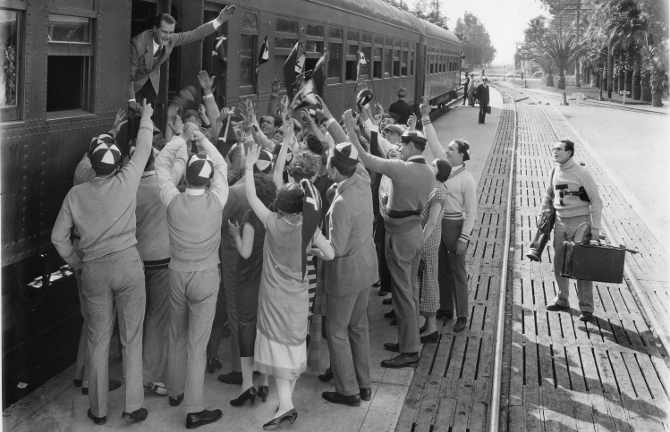Setting out to film (firstly) the climactic football scene at the Rose Bowl (stadium) in Pasadena, California for his 1925 feature The Freshman, Harold Lloyd soon felt like he was lost – unable to sense the character and his feelings, not able to hit the right tone for his collegiate protagonist. Scrapping the work, he decided to return to Hollywood and shoot sequentially – a rarity for any motion picture. It was typical for Lloyd and his team to come up with the major set pieces first (a perfect example being the football sequence) – shooting it at the very beginning, but in this case, Lloyd felt like this format was better suited, as it would add depth and continuity as the actors grew into this very character driven story.
Becoming a major spectacle (and Harold Lloyd’s highest grossing film), it spawned an immense number of college sports movie knock-offs that would dominate the theatre scene for the next several years (a prime example, Lloyd’s character is utterly inspired by a fictional college student found in a fake movie made up for this one titled “The College Hero” – two years later, The College Hero was released by Columbia Pictures). Following Lloyd’s Harold ‘Speedy’ Lamb (notice his nickname is the title of his 1928 New York set picture), the teen is heading off to Tate University – a school that is football crazy. While en route, he meets a shy, sweet hearted ingenue named Peggy (Jobyna Ralston) – timid love at first sight.
With a wonderful spirit, the naïve young man is gunning to be the most popular man on campus. Gullibly tricked by The College Cad (Brooks Benedict), he does not know that he is the butt of a number of school-wide jokes. Thinking he is growing evermore popular, he tries out for the football team. After the tackling dummy breaks on the Coach (Pat Harmon), he decides to use the eager beaver instead. Feeling slightly bad that he is about to cut him (especially after the spirited man continues to rise and take a major beating), team star Chet Trask (James H. Anderson) convinces him that they can pretend that he is on the team while relegating him to the lowly job of ‘waterboy’. Will Speedy get his chance to succeed on the football field, or will he only continue to embarrass himself?
A brilliant example of the spirit of the Roaring Twenties, there is a palpable optimism – seen in the belief and unsatiable desire for our protagonist to succeed at all costs (something very important at the time). Though an ordinary joe (the special way in which Lloyd developed his ‘Glasses’ character), he, like everyone else, has the opportunity to succeed through hard work and perseverance. The vibrancy and prosperity in society at this time is transparent – symbolic of nationwide belief in the American Dream.
Filmed on sets and throughout Los Angeles, there is a realism to life in The Freshman. The concluding football moments were shot at Memorial Stadium in Berkeley, California (several scenes actually done during the Big Game between UC Berkeley and Stanford in November 1924) with actual football players from USC – where many of the college sequences were filmed, taking part in the onscreen shenanigans. With multiple on-location moments, this is an architecture lover’s dream, as it is an authentic example of the look of this area circa the mid 1920s.
Likewise, there are other integral references to the time found throughout. Speedy’s father thinks he has picked up a radio signal from China – a joke on how some early listeners believed they could intercept a station from across the Pacific Ocean. The Fall Frolic is another major set piece (in which Lloyd struggles with a suit – helped by a tailor [Joseph Harrington] who is always close to fainting), the music (the band seen was actually playing jazzy tunes – unlike most films from the time), the dance (i.e. the Charleston), the hip flask (alcohol hidden due to Prohibition), flappers, and other such touches make for an immersive and historic experience.
Directors Fred C. Newmeyer and Sam Taylor, along with Harold Lloyd (who, despite lacking a director’s credit, still held creative control over the piece), make The Freshman much more than a comedy. Harshly treated by his peers, there is definitely a dramatic element to Speedy’s treatment. The behind your back cruelty still relates, with bullying continuing to be an alarming topic. Romance also plays an integral part, with Ralston’s Peggy being an emotional equal and motivational player in his life – her pep talk that Speedy should be himself, a simple yet worthwhile message for one and all.
Intriguingly, The Freshman also had a sequel of sorts many years later (1947 to be exact), titled The Sin of Harold Diddlebock, written and directed by comedy great Preston Sturges. In it, Lloyd returned to the role (coaxed out of a nine year retirement by the filmmaker), starting the narrative immediately after the ending of The Freshman – though, unlike the original, it was not a box office success due to many reasons, including producer Howard Hawks’ meddling (he re-shot and re-edited, releasing it as Mad Wednesday in 1950) and Sturges’ unwillingness to give any creative power to Lloyd (also, his more cynical world-view did not exactly mesh with Lloyd’s optimistic outlook either). It was the last film Lloyd would ever star in.
Often compared to Buster Keaton’s 1927 feature College, The Freshman is usually considered the better of the two classics, though it is worth checking out College as well. The Freshman has a more in-depth, nuanced and diverse story compared to the very vignette driven College. So, take a note on this classic comedy, it is a touchdown of a film.


